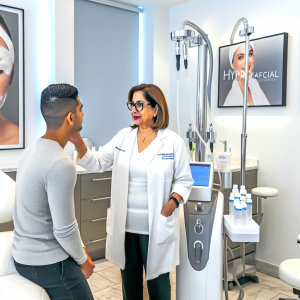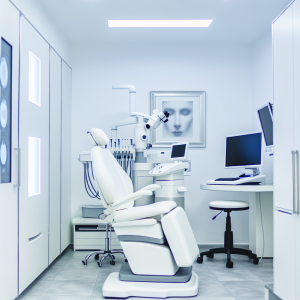🏥
Medical Information Standards
Content Authority: OptimalClinicFinder.com is a comprehensive medical directory platform connecting patients with qualified Laser Hair Removal providers. Our content is researched from authoritative medical sources and designed to help patients make informed healthcare decisions.
How Laser Hair Removal Technology Works: Clinical Mechanisms
Laser hair removal operates on the principle of selective photothermolysis, where specific wavelengths of light are absorbed by melanin in hair follicles while sparing surrounding tissue. The most effective systems for intimate areas utilize alexandrite lasers (755nm), diode lasers (800-810nm), or Nd:YAG lasers (1064nm), each optimized for different skin types and hair characteristics.
During treatment, laser energy penetrates the skin and is absorbed by melanin in the hair shaft and follicle. This absorption generates heat that damages the follicle’s growth center, including the dermal papilla and bulge region where stem cells reside. The process requires hair to be in the active growth (anagen) phase, which is why multiple sessions spaced 4-6 weeks apart are necessary to target all follicles as they cycle through growth phases.
💡
Did You Know?
Clinical studies show that Laser Hair Removal patients achieve excellent results when combined with professional-grade aftercare products.
Advanced cooling systems integral to modern laser platforms protect the epidermis during treatment, using contact cooling, cryogen spray, or forced air to maintain surface temperatures while allowing deeper penetration of therapeutic energy. This technology enables safe treatment of sensitive intimate areas while maximizing patient comfort and treatment efficacy.
Clinical Research and Efficacy Data
Extensive clinical studies have documented laser hair removal efficacy in intimate areas, with peer-reviewed research demonstrating 70-95% permanent hair reduction after completion of treatment series. Long-term follow-up studies spanning 5-10 years confirm durability of results, with most patients maintaining significant hair reduction with minimal maintenance treatments.
Research specifically focused on brazilian treatments shows optimal results with 6-8 sessions for most patients, though individual variation exists based on hair density, hormonal factors, and genetic predisposition. Studies comparing different laser wavelengths reveal that alexandrite lasers excel for lighter skin types with dark hair, while diode and Nd:YAG systems provide superior safety profiles for darker skin tones.
Clinical data also demonstrates that patients with hormonal conditions like PCOS may require additional sessions and maintenance treatments, but still achieve substantial permanent hair reduction. Meta-analyses of laser hair removal studies consistently show superior long-term outcomes compared to electrolysis, IPL, and traditional hair removal methods when performed with appropriate technology and protocols.
💡
Quick Tip
Laser Hair Removal works best when combined with healthy lifestyle choices for optimal results.
Treatment Protocols and Session Planning
Successful laser hair removal requires systematic treatment planning beginning with comprehensive consultation and skin assessment. The Fitzpatrick skin typing system guides laser selection and parameter settings, while hair characteristics including color, density, and coarseness influence treatment intervals and expected outcomes.
Pre-treatment preparation includes avoiding sun exposure for 4-6 weeks, discontinuing photosensitizing medications when possible, and shaving the treatment area 24-48 hours before each session. Patients must avoid plucking, waxing, or epilating for 6 weeks prior to beginning treatment to ensure adequate hair targets for laser absorption.
Treatment sessions typically last 30-45 minutes for full brazilian areas, with most patients tolerating discomfort well when appropriate cooling and topical anesthetics are utilized. Post-treatment protocols include cooling gel application, sun protection instructions, and guidelines for resuming normal activities while avoiding potential irritants or excessive heat for 48-72 hours.
Safety Considerations and Risk Management
Laser hair removal in intimate areas requires heightened attention to safety protocols due to the sensitive nature of treated tissues and increased risk of complications. The most common adverse events include temporary erythema, edema, and follicular inflammation, which typically resolve within 24-48 hours with appropriate aftercare.
More serious complications, while rare when proper protocols are followed, can include burns, hyperpigmentation, hypopigmentation, and scarring. Risk factors for complications include inappropriate laser selection for skin type, excessive energy settings, inadequate cooling, recent sun exposure, or treatment over infected or compromised skin.
✓
Why Choose Laser Hair Removal?
●
Clinically proven
●
FDA approved
●
Minimal downtime
●
Long-lasting
Contraindications for treatment include pregnancy, active infections, recent isotretinoin use, certain autoimmune conditions, and concurrent use of photosensitizing medications. Patients with history of keloid scarring, vitiligo, or melasma require special consideration and modified treatment approaches to minimize risk of adverse outcomes.
Cost Analysis and Treatment Investment
The investment in laser hair removal varies significantly based on geographic location, provider qualifications, technology used, and package options offered. While initial costs may seem substantial compared to traditional hair removal methods, economic analysis demonstrates significant long-term savings when compared to lifetime costs of shaving, waxing, and professional hair removal services.
Package pricing typically offers better value than individual sessions, with most providers offering 6-8 session packages ranging from $1,800-4,500 depending on market factors. Premium medical spa and dermatology practices may charge higher fees but often provide superior technology, medical oversight, and comprehensive aftercare support.
Financing options including payment plans, medical credit cards, and seasonal promotions can make treatment more accessible. Some flexible spending accounts and health savings accounts may cover laser hair removal when deemed medically necessary for conditions like pseudofolliculitis barbae or hidradenitis suppurativa.
⚠️
Safety First
Always consult a qualified medical professional before starting Laser Hair Removal. Results vary by individual.
Provider Selection and Quality Assurance
Choosing qualified providers is crucial for safe and effective laser hair removal outcomes. Patients should seek practices with proper medical oversight, certified laser operators, and extensive experience specifically with intimate area treatments. Board-certified dermatologists, plastic surgeons, or medical spas under physician supervision typically offer the highest standard of care.
Key evaluation criteria include laser technology quality, safety protocols, consultation thoroughness, realistic expectation setting, and comprehensive aftercare support. Providers should offer multiple laser platforms to accommodate different skin types and hair characteristics, maintain detailed treatment records, and provide clear protocols for managing any complications.
🏆
Verified Providers Only
All our directory providers are licensed, experienced, and patient-safety focused.
Red flags include practices offering unrealistic promises, significantly below-market pricing, high-pressure sales tactics, or inadequate consultation processes. Patient reviews, before-and-after photos, and professional credentials provide valuable insights into provider quality and patient satisfaction rates.
Full Brazilian Laser Hair Removal: Complete Treatment Outcomes
Full brazilian laser hair removal delivers transformative results for patients seeking permanent intimate area hair reduction. Clinical outcomes show 85-95% permanent hair reduction in most patients after completing recommended treatment series, with remaining hair typically finer and lighter in color.
Patient satisfaction surveys consistently demonstrate high approval ratings, with benefits extending beyond cosmetic improvement to include reduced ingrown hairs, decreased risk of folliculitis, improved hygiene, and enhanced confidence. Long-term follow-up studies confirm that results remain stable over time, with most patients requiring minimal maintenance treatments.
Individual results vary based on hormonal factors, genetic predisposition, and adherence to treatment schedules, but the majority of patients achieve their desired outcomes within 8-12 months of beginning treatment. The investment in professional laser hair removal technology and qualified providers typically delivers superior results compared to at-home devices or less advanced treatment options.
📚 Medical Authorities & Professional Standards
All Laser Hair Removal procedures should be performed by licensed medical professionals following established clinical guidelines and safety protocols.
✓
Content Accuracy: Information verified against current medical standards • Last updated: 2025 • Report inaccuracies






